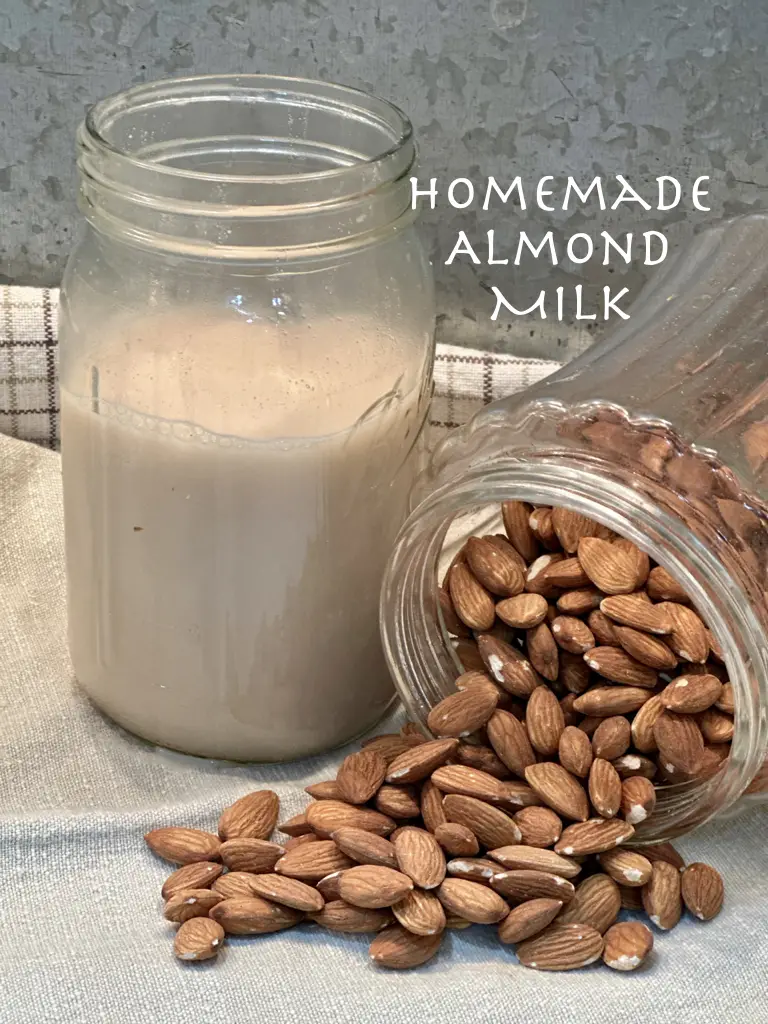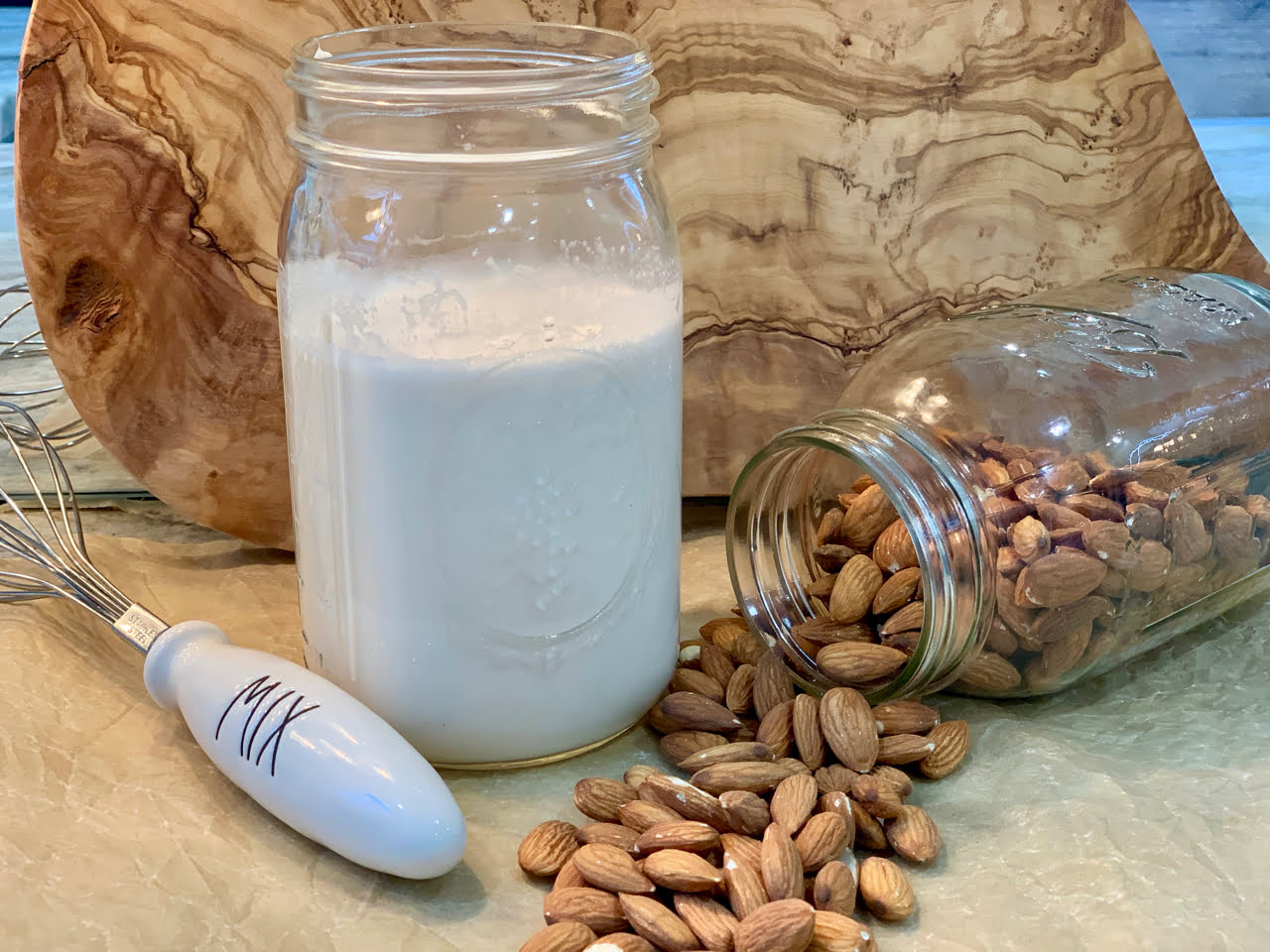The Healthiest Homemade Almond Milk is made with only two ingredients, almonds and water, and it’s too easy not to be making it yourself!

So You Think You Know All About Almond Milk!
I’d bet my bottom dollar you don’t know all about almond milk!
Why?
Well, I was born in the 50’s to a first generation Syrian mother, and almond milk was just something Middle Eastern women made at home.
In fact, one of the first documented mentions of almond milk dates back to the 13th century in Baghdad in a cookbook.
Did you know that?
Afterall, if other parts of the world, long ago, had coconut milk as part of traditional cooking, why not other parts of the world use other nuts, fruits, seeds and grain for milk!
Homemade Almond Milk In Ancient Times
As is many traditions in our world that are often rooted in religious practices, homemade almond milk is no different.
During the times of lent, it was forbidden to eat or drink anything that came for animals, for forty days.
The mention of ‘nutty water‘ dates back to those very early days of strict adherence to this religious practice.
Perfectly suited to replace dairy milk, was homemade almond milk.
Why Make Homemade Almond Milk?
I get it, convenience is a great reason to buy almond milk for a busy life.
With a blender or food processor you can make it as fast as it would take you to drive to the store to pick it up or wait for a home delivery, for a fraction of the price.
These are only a few great reasons to make it yourself, there’s more!
Have you ever read the ingredients on store bought almond milk?
What the heck is carrageenan, you ask? Seaweed.
Why is there seaweed in my milk? Thickener and preservative, that’s why.
Homemade almond milk doesn’t have nor need any of that to make it creamy, rich or delicious. Just nutty nuts and water!
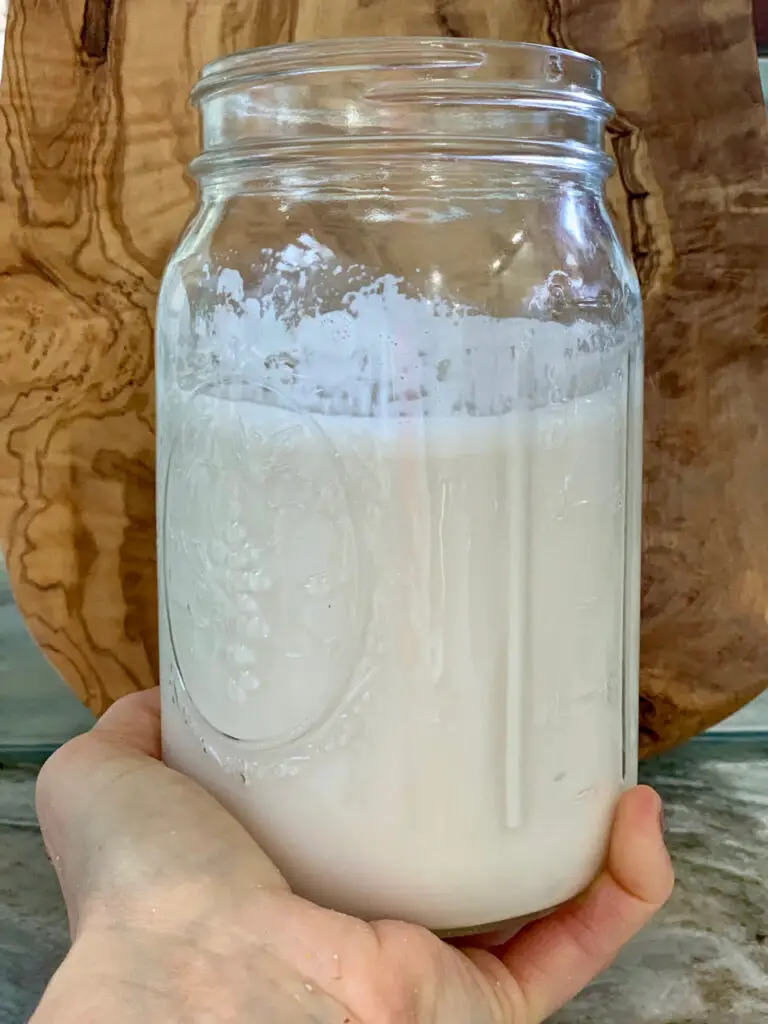
Health Benefits Of Homemade Almond Milk
Most people who drink almond milk or use it in their foods do so because they are lactose intolerant.
Many of us who are not lactose intolerant drink almond milk simply because it tastes delicious and has lots of good nutritional benefits.
Almond milk has up to 6 grams of protein per 1 cup serving.
It has about 8% of the daily recommended calcium and has a good amount of iron per serving.
All of those reasons are why I drink almond milk as well as dairy milk.
How To Make Homemade Almond Milk
Almond milk couldn’t be easier to make.
The only two tools you will need are a blender or food processor, and cheesecloth, a nut milk bag, or a fine mesh strainer.
Soaking raw almonds overnight in water softens them, making it easiest to extract the most from their flavor.
This step can be sped up by soaking for 15 minutes in boiled water with a cover; not as perfect as the long soak but pretty darn good.
And so, I’ve devised a procedure that is sort of between these two.
It is easy to do the first step in the morning, and by day’s end the almonds are ready to extract, pop in the fridge and be ready for breakfast!
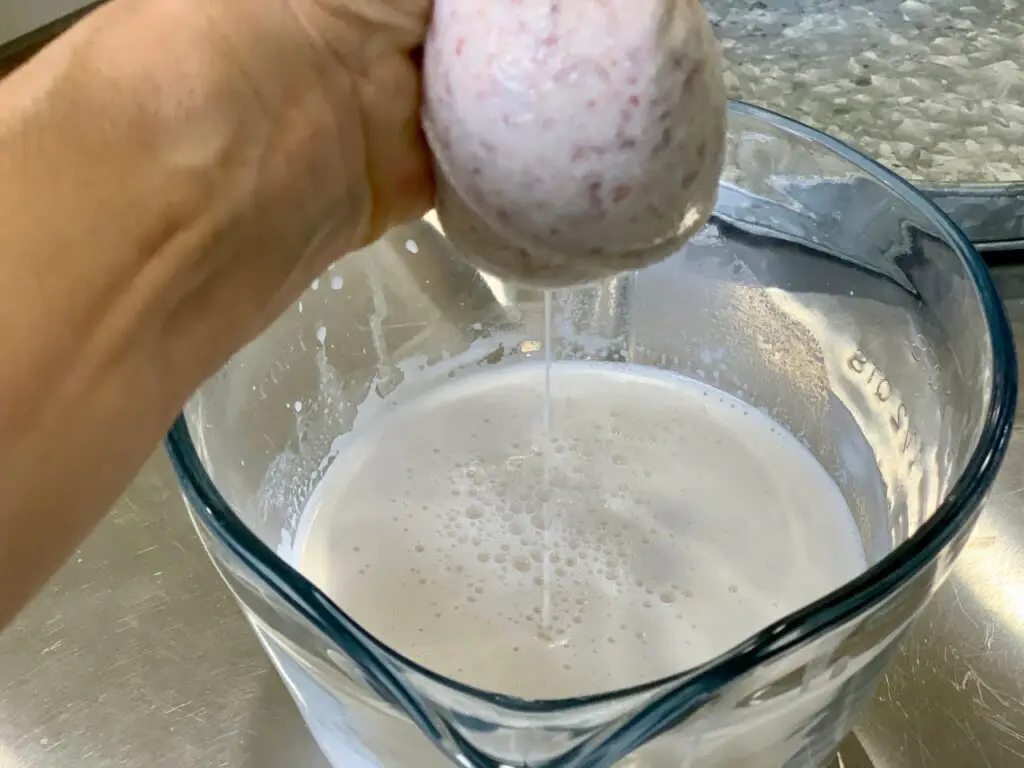
Almond Milk Isn’t The Only Dairy-free Milk In Town!
While almond milk is among the more popular of plant milk options in grocery stores, there are so many others.
The same exact steps for making almond milk are used to make cashew milk, pistachio milk, walnut milk, pecan milk, sesame seed milk or oat milk.
Think how much you’ll be saving on the cost of these specialty milks, and without the added preservatives, if you make it yourself!
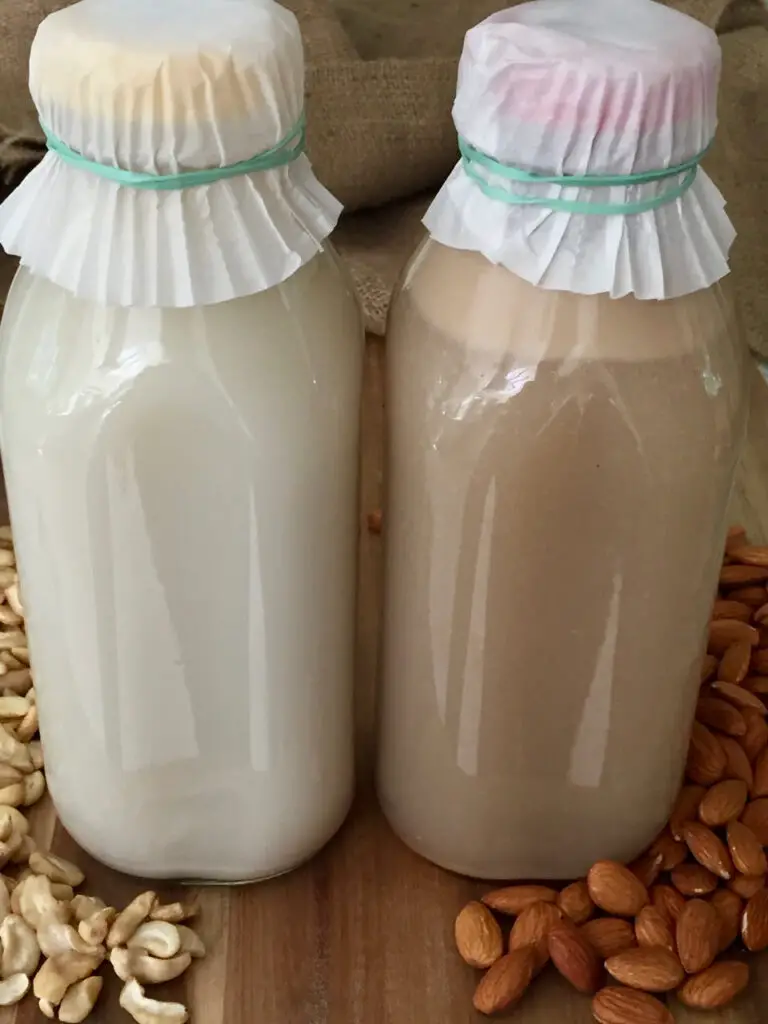
What To Do With The Remaining Almond Pulp When Grinding Almonds For Homemade Almond Milk?
Don’t even think about throwing the almond pulp away!
Add the pulp to your favorite muffin recipe, a smoothie, mix with yogurt for your morning parfait or use them in a fantastic Biscotti recipe!
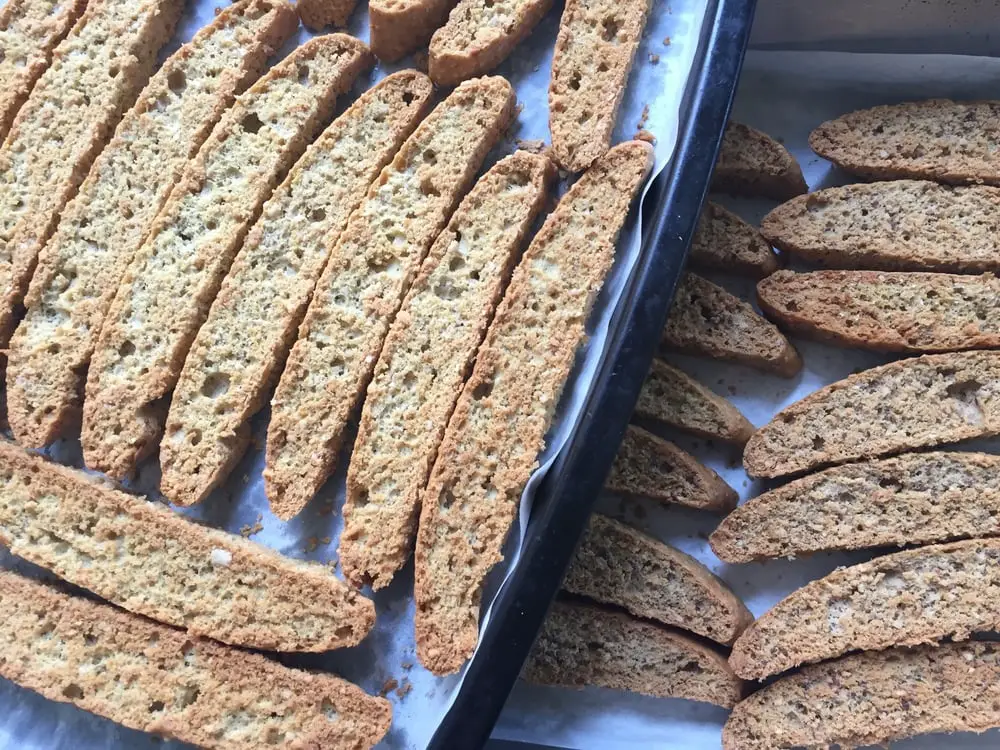
I’ve even created a yeast bread recipe, around the holidays, just so I could use the pureed almonds.
It is an Almond Cranberry Yeast bread and so delicious when sliced for morning toast.

Homemade Almond Milk Is More Than A Dairy Replacement
I do love my dairy, and no, I am not lactose intolerant, but I am calorie conscience.
For this reason, I first started making my own almond milk to use in recipes I love, but might otherwise have more calories than I want.
In the heat of summertime, popsicles and ice cream are a treat for me.
And so I created a Lavender Blueberry Popsicle with my almond milk. Less calories, more flavor and so much more refreshing!
Summer, however, is not the only time I like a refreshing frozen treat.
As a light, after dinner sweet treat in the dead of winter, when meals are much more substantial than summer, I made a Cranberry Orange Sorbet with almond milk.
The warm spices of winter, the tart, yet sweet of cranberries and oranges married beautifully with almond milk.
A dairy milk could never have worked because the acidity would have broken the cream and soured it.

Ingredients Needed
- Raw Almonds
- Water
- Sweetener (optional)
Equipment Needed
- Food processor
- Large bowl
- Strainer, cheesecloth or the Nut Milk bags (below) I find so easy to use
- 32-oz Mason jar with an easy to use pour spout lid
Healthiest Homemade Almond Milk
Equipment
- 12×12 inch Cheesecloth or nut bag of fine mesh strainer
- 32 oz Jar with lid
- Medium saucepan with lid
Ingredients
- 1 cup Raw Almonds crushed
- 4 cups Water boiling
Instructions
- Place the water in a medium size saucepan and bring to a boil. Add the crushed almonds (do not boil), remove from the stove and put a lid on. Allow to sit room temperature for at least 6 hours or over night.
- Pour the entire mixture through a fine mesh sieve or cheesecloth, into a bowl large enough to hold 32 ounces. Press and squeeze as much milk out of the almonds as you can. Towards the end is where the creamiest liquid will extract from the almonds.
- Transfer the milk to a container with a lid. Store in the refrigerator for up to a week.
Video
Notes
- Milk from other nuts or oats can be made exactly the same as this recipe.
- A great sweetener is dates! Simply soak and puree one pitted date with the almonds when making the milk.
- If you wish other sweeteners or the addition of a splash of vanilla, add it once you transfer the milk to its final airtight container.
